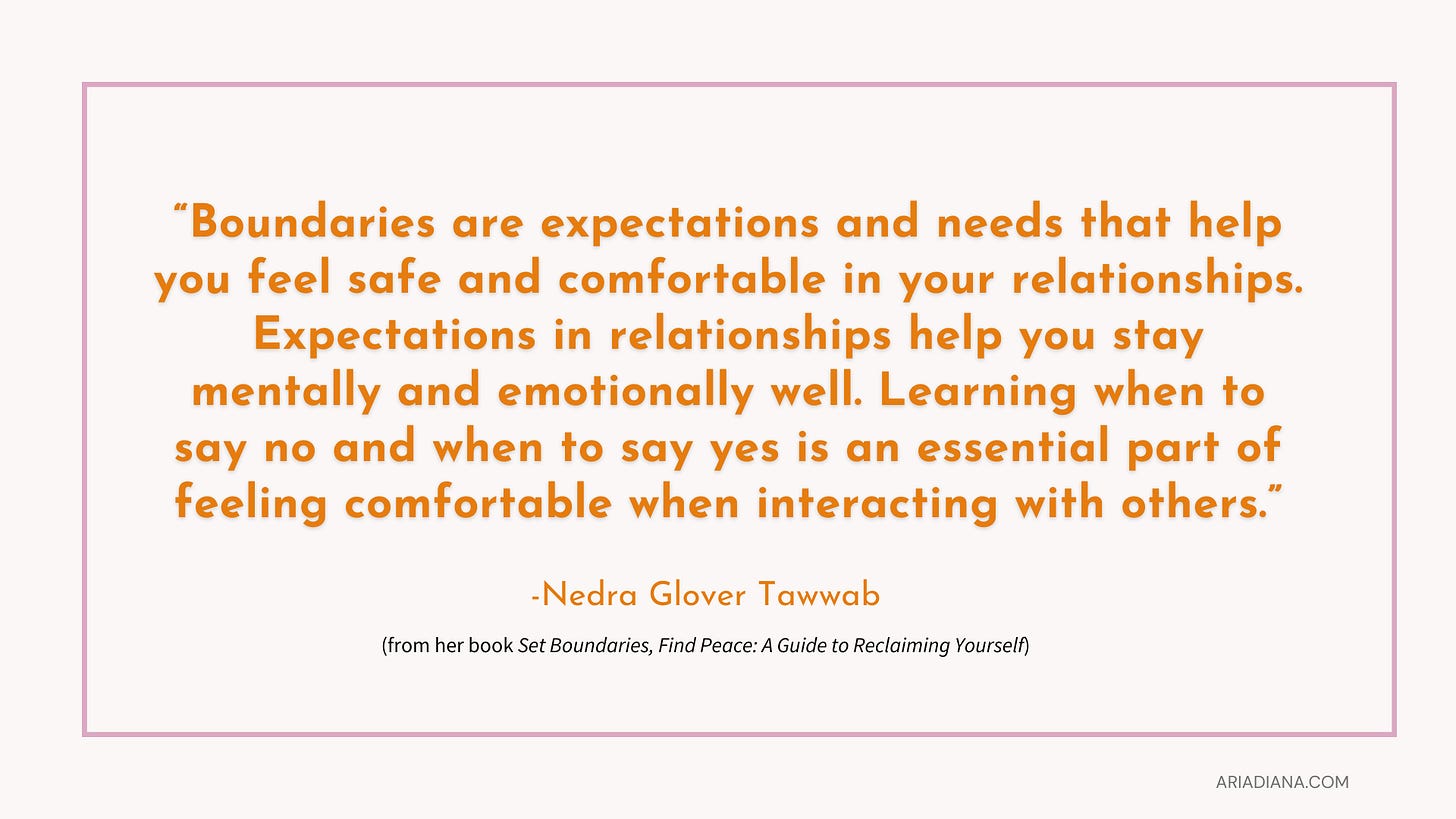5 Areas to Consider Making Explicit Boundaries in Non-Monogamous Relationships
An invitation to know and advocate for our needs to craft relationship(s) in intentional and mutually agreed upon ways
Love may know no bounds, and it’s so important to remember that our time and energy are finite. By getting clear about our boundaries in emotional, communication, physical, sexual, and financial realms, we can foster deeper trust and get clear on expectations to create relationships that offer mutual fulfillment.
What’s beautiful about non-monogamy is that it gives us spaciousness and freedom to explore relationships with others in creative ways. It’s easy to get carried away in the excitement of “new relationship energy” (or “NRE”), so it’s also essential that we are practical and honest with ourselves and others about what our capacity to be in connection with each other actually looks like. Because there are so many different ways to do non-monogamy, it’s important we’re communicating about how we are available to be in connection when we’re operating outside of the rigid confines and known contours of monogamy’s “relationship escalator”.
When we stop making assumptions about the direction and shape our intimate relationships will take, we’re invited to dream up and design new, intentional landscapes together that we both want to explore and inhabit. When we stop expecting that a loving relationship must include cohabitating, legal contracts, and shared bills to be successful or valid, we have more free reign to craft diverse paths of relating that may take us into exciting, novel territory.
When there’s no clearly defined roadmap for what the connection will look like, boundaries serve as essential pillars that point us towards a mutually agreed upon shape the connection could take, based on respect, bandwidth and overlapping desires.
The ability to know and speak our desires is powerful, and especially for people socialized as women, it’s an essential skill to practice—our patriarchal culture teaches us to stay small and silent and people please. Through mindfulness and meditation, we can more deeply cultivate awareness of our internal landscape and honor our senses as a fundamental language that helps us feel into our needs and boundaries. When we truly understand our own needs (and are able to deeply trust that they’re valid and worth advocating for), we can establish boundaries from a place of centeredness, rather than an emotional reaction to a triggering experience.
As we learn to more complexly relate in deeper ways to multiple humans simultaneously, it’s wise to consider thinking more about our needs and expectations, and possibly making explicit boundaries and agreements with partner(s) and lovers in these five crucial domains:
1. Emotional & Mental Boundaries
2. Communication & Time Boundaries
3. Physical Boundaries
4. Sexual Boundaries
5. Financial & Material Boundaries
A soft approach to setting boundaries involves communicating your limits or needs in a gentle, respectful, and non-confrontational manner. Instead of being assertive or aggressive, you express your boundaries with empathy and understanding, taking into consideration the feelings of others. This approach aims to maintain positive relationships while still asserting your personal limits or preferences. It might involve using the principles of nonviolent communication and "I" statements to express how certain behaviors make you feel or calmly stating what you're comfortable with or not comfortable with. Overall, the soft approach prioritizes maintaining harmony while still asserting your needs.
1. Emotional & Mental Boundaries
Setting emotional and mental boundaries requires a delicate balance of empathy and self-awareness to articulate our preferences for emotional and intellectual engagement.
Emotional boundaries help us get clear on what is and isn't ours to feel / fix. What kind of emotional support helps you feel safe? Consider defining the type of care (including pre-date and post-date after-care you like to receive). Consider identifying and informing your partner(s) know about your love language (how you like to give and receive affection: words of affirmation, quality time, physical touch, acts of service, or receiving gifts).
It can be so helpful to learn more about your dominant attachment style and how it might interact with the way your partner(s) relate. Do either of you tend to be avoidant, anxious or disorganized? Bringing awareness to our attachment styles helps us understand patterns in our emotional states; when we know a partner has a pattern of shutting down when conflict is present, we can more gently engage with each other and work to improve the ways we connect.
You may need mental boundaries if differences in values or processing styles lead to arguments or hurt feelings. Are there places where you hold different beliefs? Are there certain topics you’re not willing to discuss? Can you respect each other’s opinions and identity, even if you have an opposing view?
A few examples of soft approaches to setting mental and emotional boundaries:
“I can tell you’re having a really hard time processing your breakup with him, and I know it’s hard right now. I want to support you, but I am noticing I’m getting overwhelmed hearing some of the details of your connection with this other person. I’m happy to snuggle with you, but do you think you could talk to your therapist or another friend about some of the mental processing I can tell you’re needing around this other relationship?”
"I appreciate your concern, but I need some space to process this situation on my own before discussing it further. Can we revisit this conversation later?"
2. Communication & Time Boundaries
Effective communication and time management form the bedrock of thriving relationships. If you have multiple partners, it can be helpful early on to establish clear expectations of frequency of communication and frequency of time together. How often are you available to be in touch? Are there certain times when you’re not available for texts or calls? How much bandwidth and availability do you have to spend with each other? By clearly delineating preferences and bandwidth, we can foster an environment of mutual respect and attentiveness without getting overwhelmed or resentful.
It’s also important to establish disclosure protocols; if you have other lovers or partners, clarify what details of your connection gets shared with others, and what’s just for you two. Foster a transparent environment but avoid making assumptions or overwhelming each other with too much information. Consider the emotional impact of what you share.
Need help figuring out how to create disclosure boundaries? Schedule a free 30-minute consultation with me.
Partners often benefit from having regular check-ins (using communication tools like T.E.A.M or F.R.E.S.H) to create space for proactive communication and to revisit agreements.
Before introducing a new partner to other partners, metamours, close friends or family members, it can also be helpful to clarify what you both feel comfortable sharing with others about your new relationship, and anything you both need to feel safe and supported in those interactions. Not everyone is fully out of the non-monogamy and/or queer closet, and we don’t want to make assumptions about how others like to be identified or presented in new scenarios.
A few soft approaches to setting communication and time boundaries:
“I am loving spending time with you, and realistically I probably have the bandwidth to schedule dates with you every 2 weeks or so. How does that feel?”
"I've noticed that we often have deep discussions late at night, but I find it hard to focus and communicate effectively at that time. How about we schedule any more serious talks for earlier in the evening when I'm more alert?"
3. Physical Boundaries
Articulating preferences for sharing space with other partners or metamours can help lay the groundwork for respectful interactions. If you’re someone who practices kitchen table polyamory, you may feel comfortable being in the same room with your partner’s partner, but that might feel uncomfortable for someone newer to non-monogamy.
In terms of personal space and preferences, consider asking new partners questions like: What are your comfort levels with physical affection in public versus private settings? What kind of physical touch is welcome or unwelcome? Clarify how you like to be touched, any areas of your body that need extra tenderness, or types of touch that are off-limits or that needs your explicit consent before engaging.
A few soft approaches to setting physical boundaries:
“I just learned my other partner bought a ticket to the concert we were thinking about attending together this weekend. How would you feel about sharing space with them in that setting?”
"I love physical affection, but I'm sensitive about being touched on the back of my neck due to a past injury. Could we avoid that area?"
4. Sexual Boundaries
Navigating sexual boundaries demands open dialogue and mutual respect. Establishing a shared understanding of safer sex practices and creating space for open discussion around STI status and testing practices fosters a culture of sexual health and empowerment. Consider proactively sharing with potential partners about how you define safer sex, what you need from others to engage sexually with them (ie. knowing their STI status and/or being willing to share test results), how frequently you each get tested, etc. By honoring individual comfort zones and preferences, individuals can create spaces of intimacy imbued with safety and mutual consent, trust and care.
A few soft approaches to setting sexual boundaries:
"I'm committed to practicing safe sex, so before we take things further, I'd like to discuss our STI statuses. Do you feel okay having an explicit conversation about that with me?"
"Exploring new things together is exciting, but I'm not comfortable practicing shibari with someone I just met. Can we hold on that exploration while we get to know each other a little better?"
5. Financial & Material Boundaries
Financial and material boundaries safeguard autonomy and reciprocity in relationships, helping us protect our resources and possessions. Dating multiple people can be expensive! Clarify the types of dates that you like to enjoy right now based on your budget. If you share bills and finances with one partner, it can be helpful to get aligned on expectations about how much you’re each spending on dates with other people and/or what bank accounts are used for those outings.
A few soft approaches to setting financial and material boundaries:
"I appreciate your generosity in treating me to fancy dinners, but I feel more comfortable contributing financially. Let's alternate who pays for dates, or perhaps we can find more budget-friendly activities."
"My nesting partner and I been saving up for a big family trip, and right now I’m extra mindful of my spending on first dates with new people. Would you be up for a casual picnic in the park instead of a fancy dinner? I can bring a picnic blanket for us."
Boundaries serve as beacons of self-awareness and mutual respect. By engaging in intentional dialogue and negotiation across emotional, mental, communication, physical, sexual, material and financial realms, we can craft connections that are based in authenticity and trust and a desire to know and support one another. It is no doubt that to do non-monogamous relationships well, we are required to practice our ability to know our needs and advocate for them, and have nuanced conversations that invite us to negotiate about how we’re able to show up in relationship for more aligned expectations and fewer misunderstandings. In creating space for integration and reflection, we deepen our understanding of self and others, fostering relationships rooted in compassion and mutual growth.
How do you think about creating explicit agreements in non-monogamous relationship(s)? What boundaries have helped you feel safe exploring non-monogamy?






